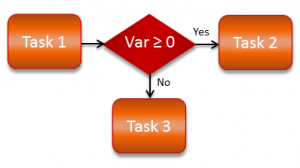 The process definition now provides support for the use of logic to drive the flow in the analysis process. One or more conditions can be defined at the analysis level to control whether an analysis will be attempted. Several scenarios that would have required specialized external scripts to capture the desired process behavior are now easily handled with this feature. Some of these scenarios are listed below:
The process definition now provides support for the use of logic to drive the flow in the analysis process. One or more conditions can be defined at the analysis level to control whether an analysis will be attempted. Several scenarios that would have required specialized external scripts to capture the desired process behavior are now easily handled with this feature. Some of these scenarios are listed below:
- Improve efficiency in the evaluation process by skipping compute intensive analyses when it is clear that the design would not be acceptable
- Continue execution of the process even when some of the analyses result in errors
- Use of an appropriate physics model based on the results of an upstream analysis Continue reading
 Many engineers still resist the use of optimization algorithms to help improve their designs. Perhaps they feel that their hard-earned intuition is just too important to the solution process. In many cases, they are right.
Many engineers still resist the use of optimization algorithms to help improve their designs. Perhaps they feel that their hard-earned intuition is just too important to the solution process. In many cases, they are right. “Creativity is just connecting things. When you ask creative people how they did something, they feel a little guilty because they didn’t really do it, they just saw something. It seemed obvious to them after a while. That’s because they were able to connect experiences they’ve had and synthesize new things. And the reason they were able to do that was that they’ve had more experiences or they have thought more about their experiences than other people.”“Unfortunately, that’s too rare a commodity. A lot of people in our industry haven’t had very diverse experiences. So they don’t have enough dots to connect, and they end up with very linear solutions without a broad perspective on the problem. The broader one’s understanding of the human experience, the better design we will have.”
“Creativity is just connecting things. When you ask creative people how they did something, they feel a little guilty because they didn’t really do it, they just saw something. It seemed obvious to them after a while. That’s because they were able to connect experiences they’ve had and synthesize new things. And the reason they were able to do that was that they’ve had more experiences or they have thought more about their experiences than other people.”“Unfortunately, that’s too rare a commodity. A lot of people in our industry haven’t had very diverse experiences. So they don’t have enough dots to connect, and they end up with very linear solutions without a broad perspective on the problem. The broader one’s understanding of the human experience, the better design we will have.” In multi-disciplinary design optimization (MDO), a similar question comes up: “how many design evaluations are needed to converge on the optimal solution?” Unfortunately, as with money, there is no universal answer. The number of evaluations required depends on the problem you are trying to solve, your approach to solving it, and the starting point for the solution. Let’s unpack this a bit.
In multi-disciplinary design optimization (MDO), a similar question comes up: “how many design evaluations are needed to converge on the optimal solution?” Unfortunately, as with money, there is no universal answer. The number of evaluations required depends on the problem you are trying to solve, your approach to solving it, and the starting point for the solution. Let’s unpack this a bit.  When Thomas Edison developed the first long-lasting, high-quality light bulb in 1879, his successful design was the result of a lengthy and laborious trial-and-error search for the best filament material, a process we now call the Edisonianapproach.
When Thomas Edison developed the first long-lasting, high-quality light bulb in 1879, his successful design was the result of a lengthy and laborious trial-and-error search for the best filament material, a process we now call the Edisonianapproach.